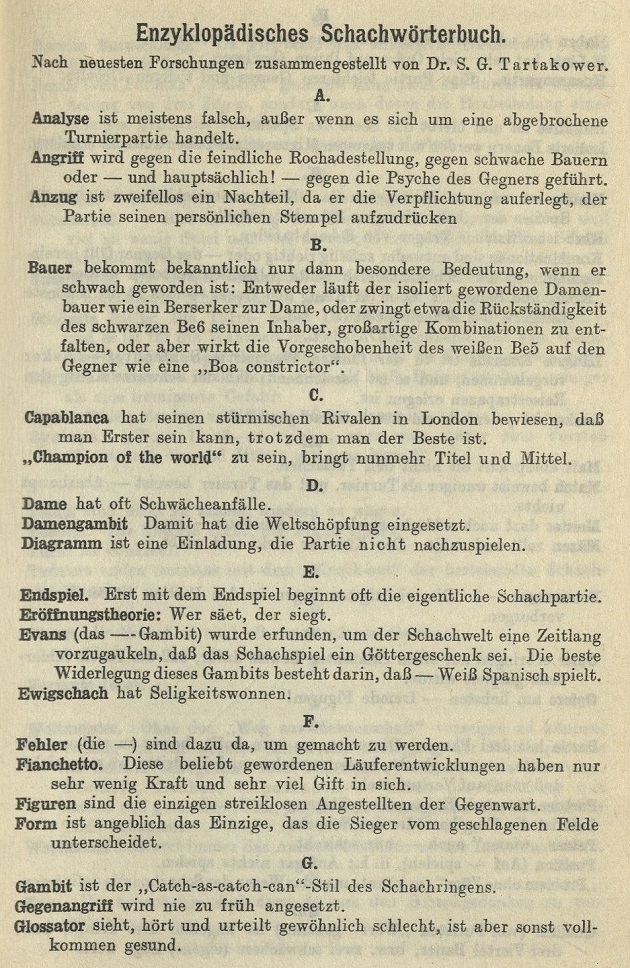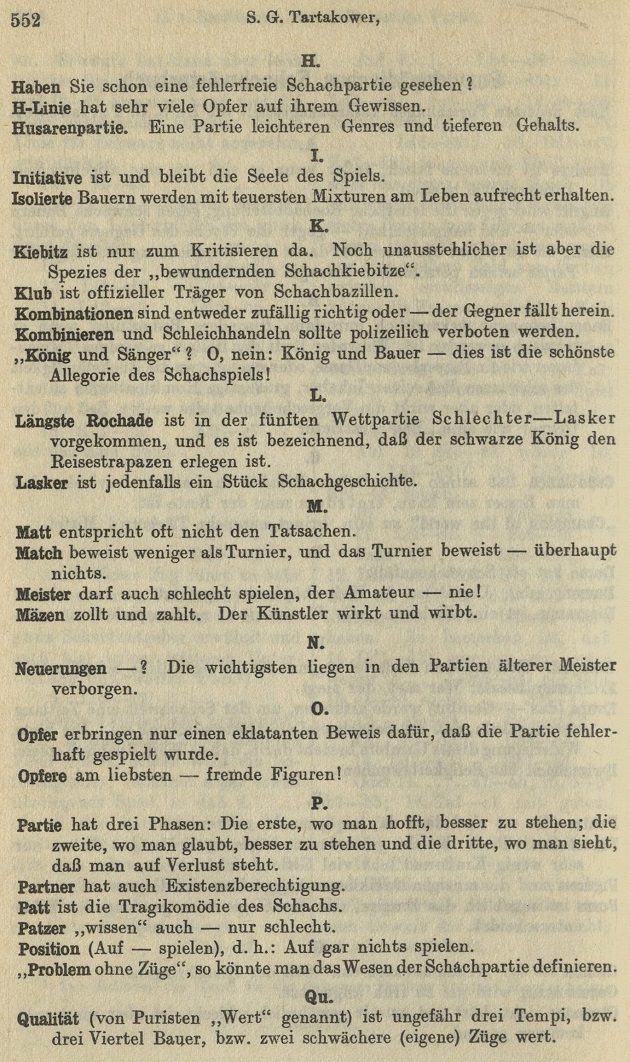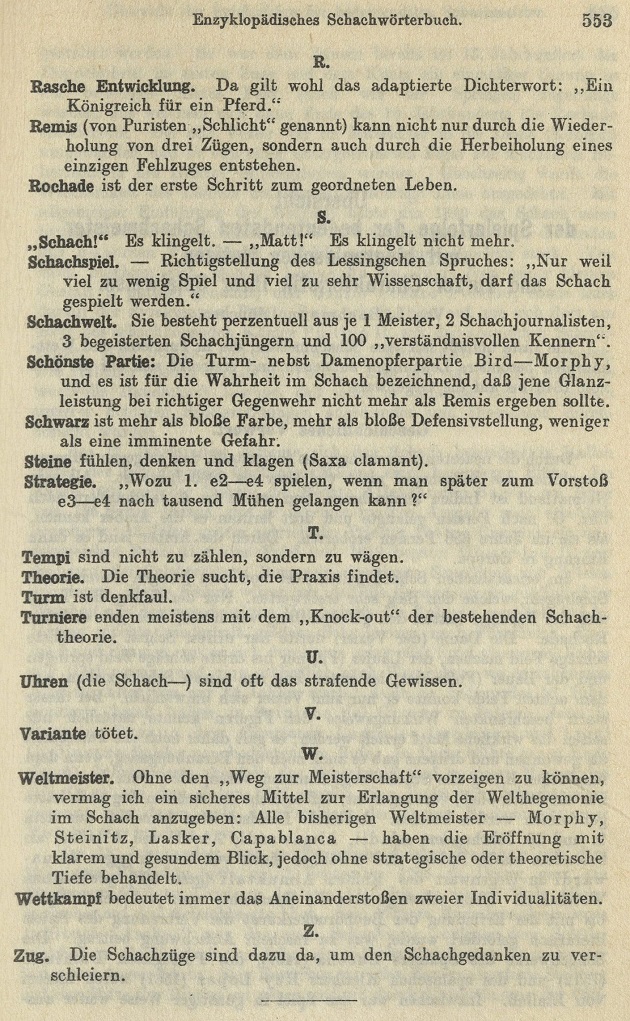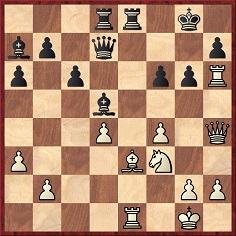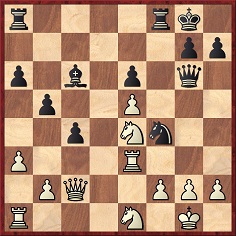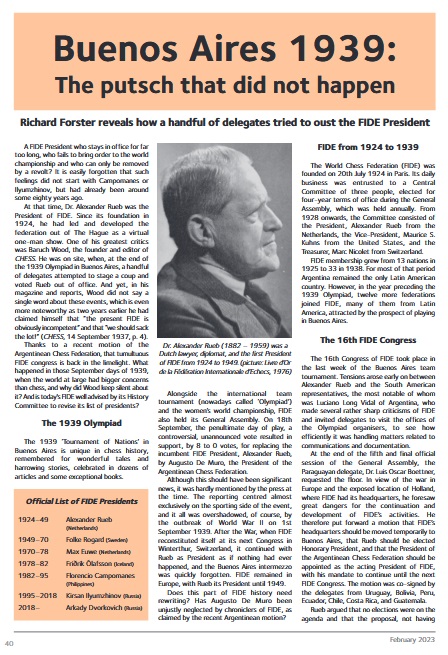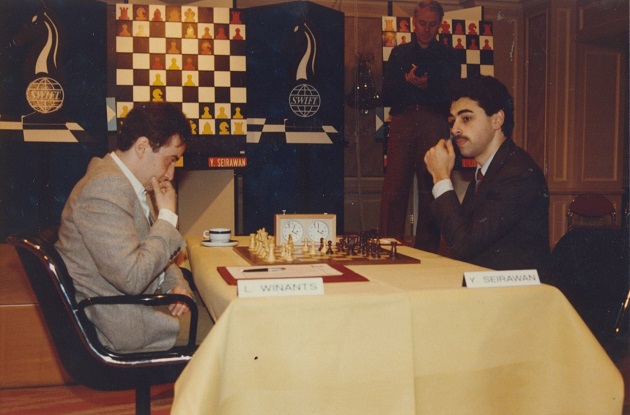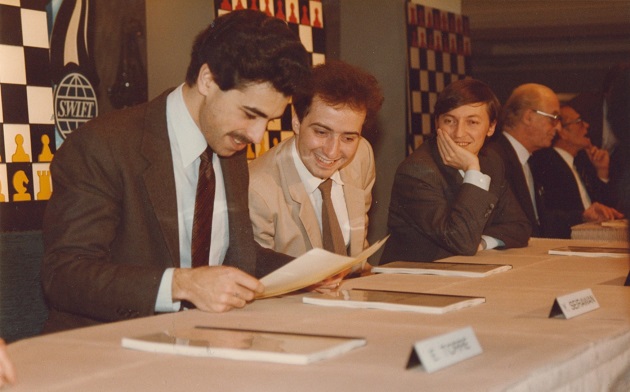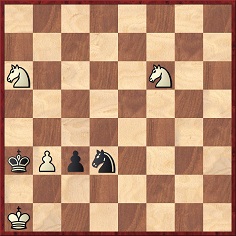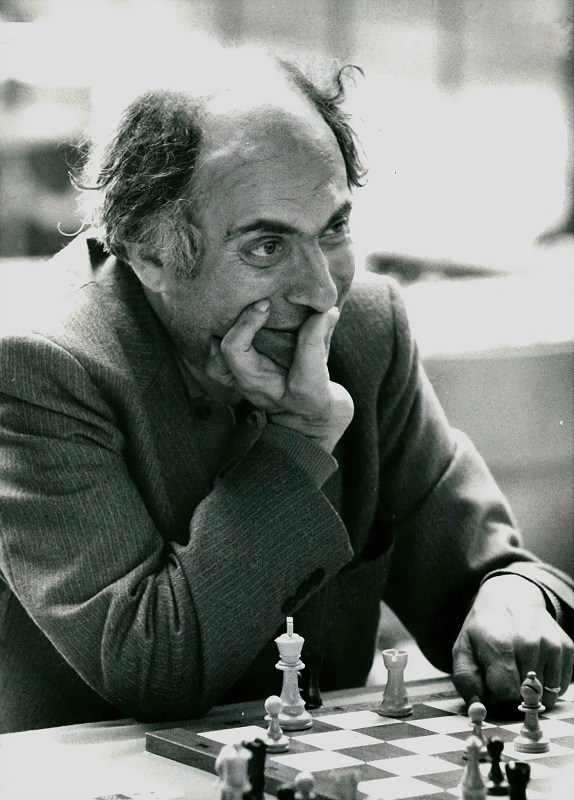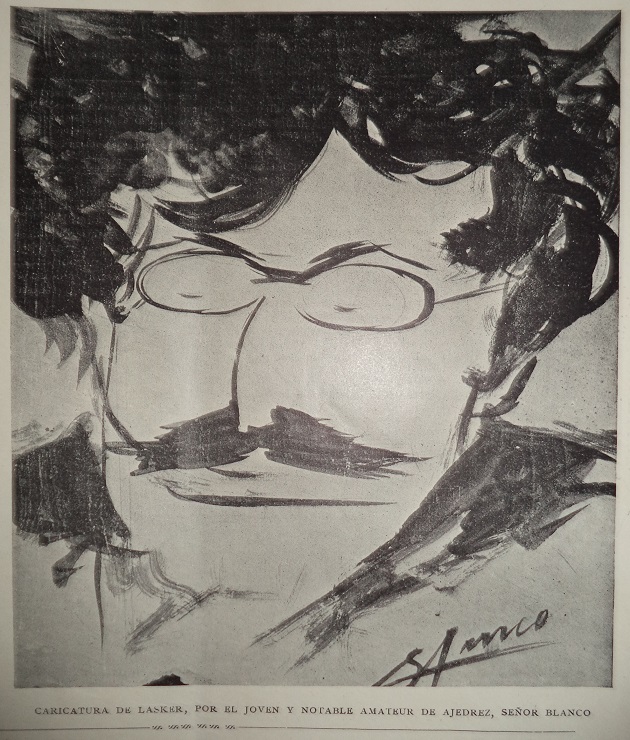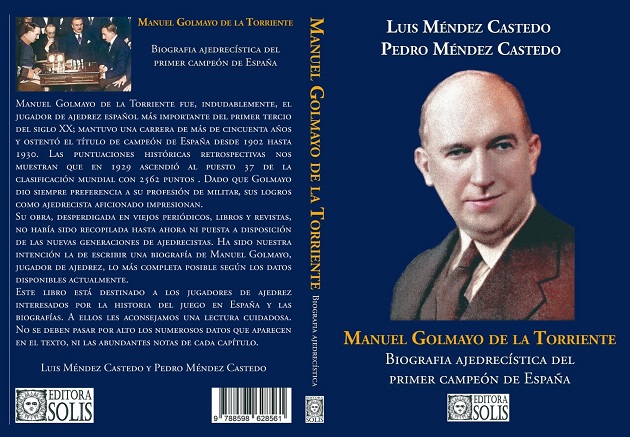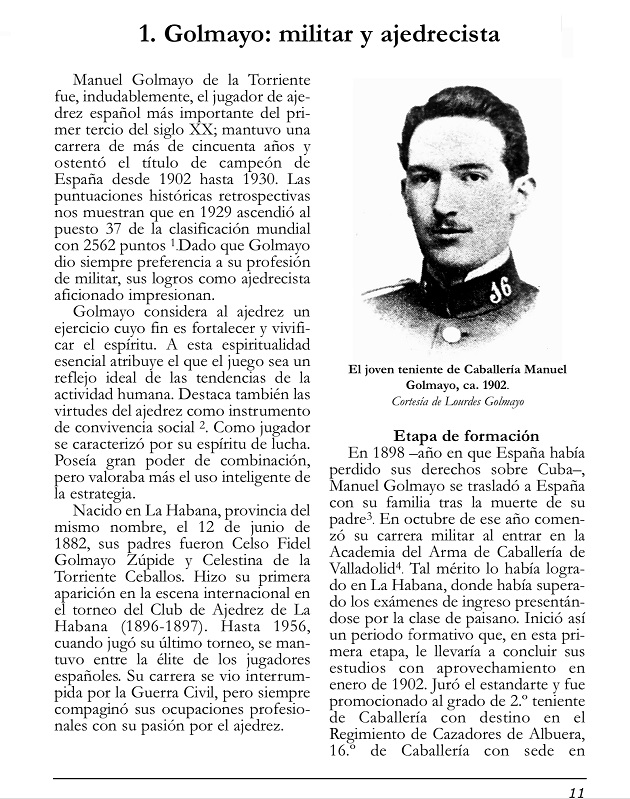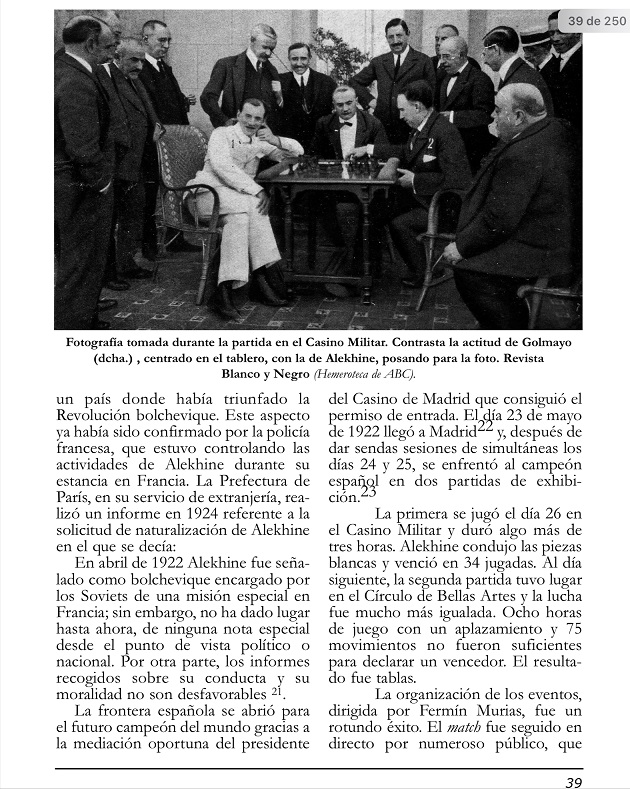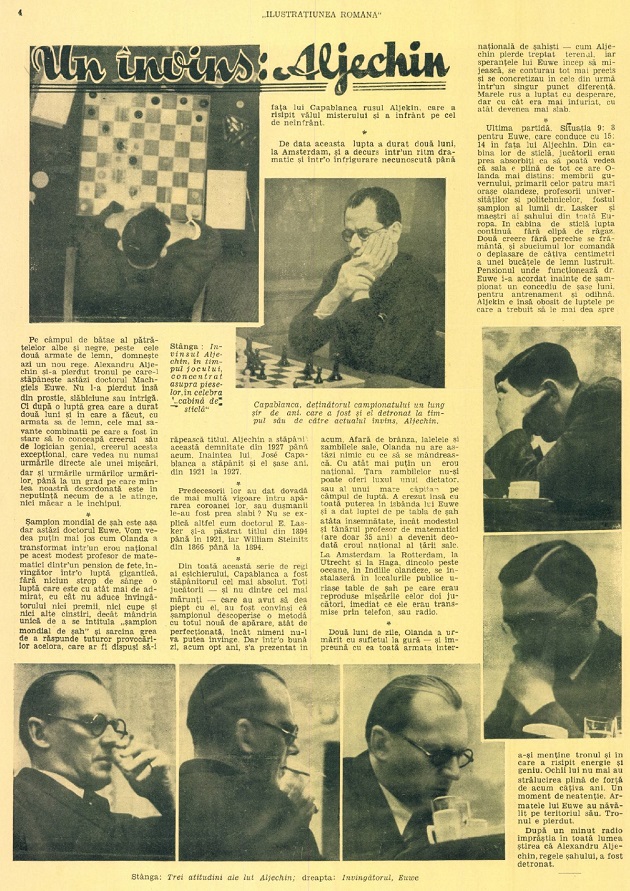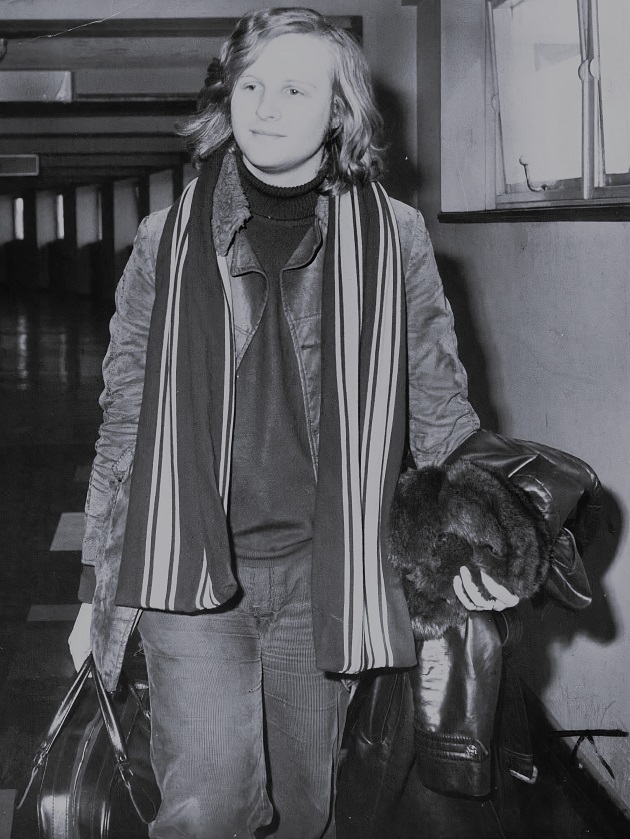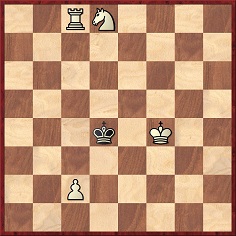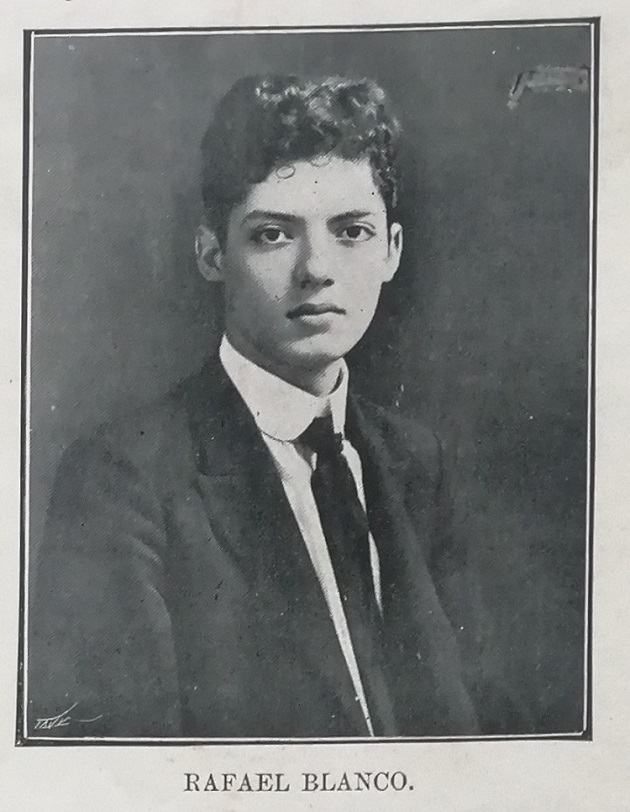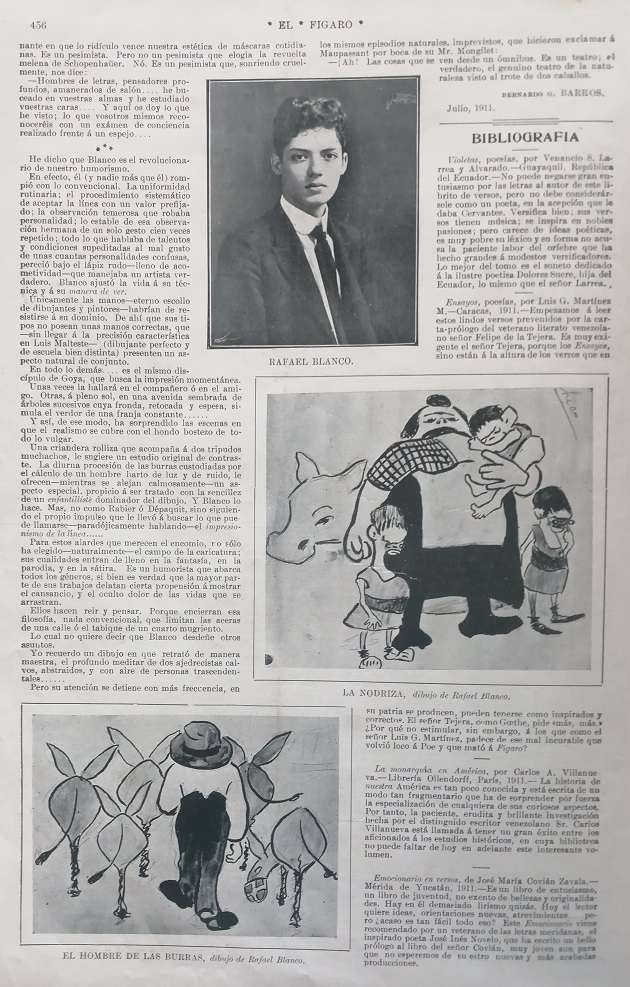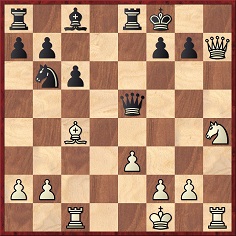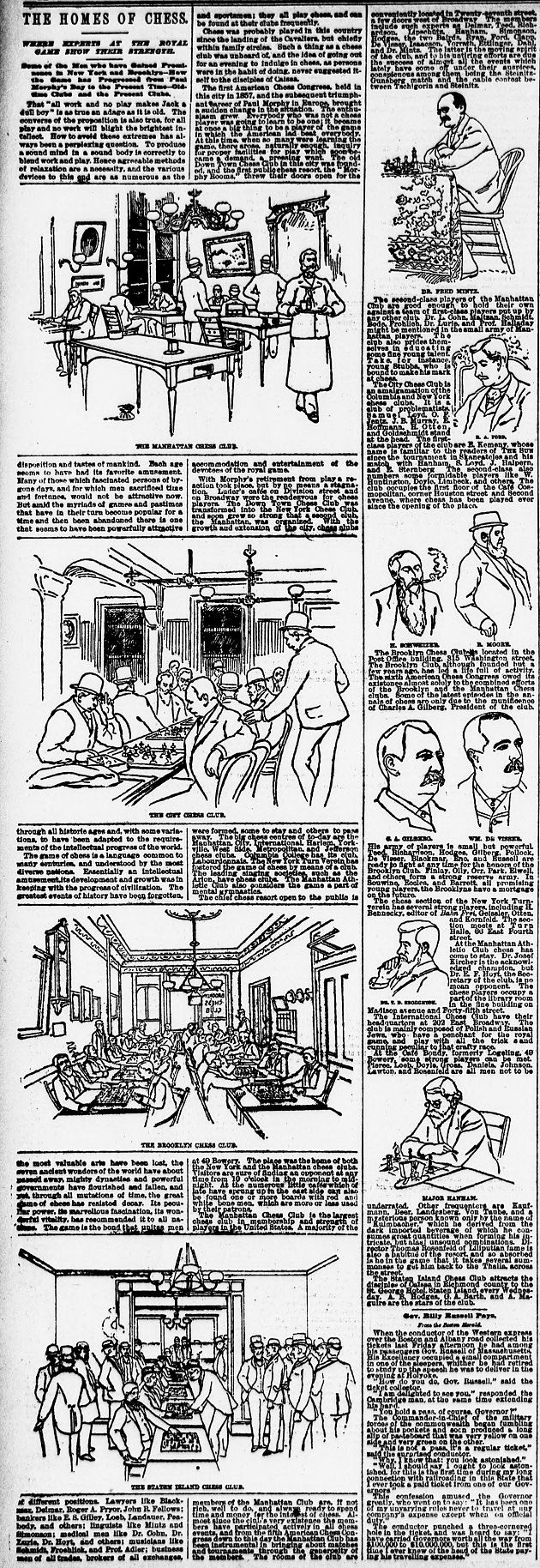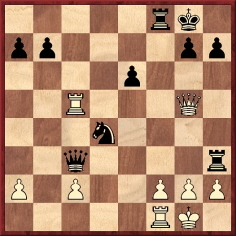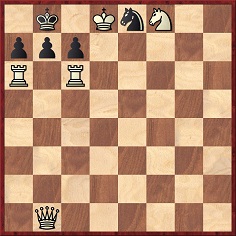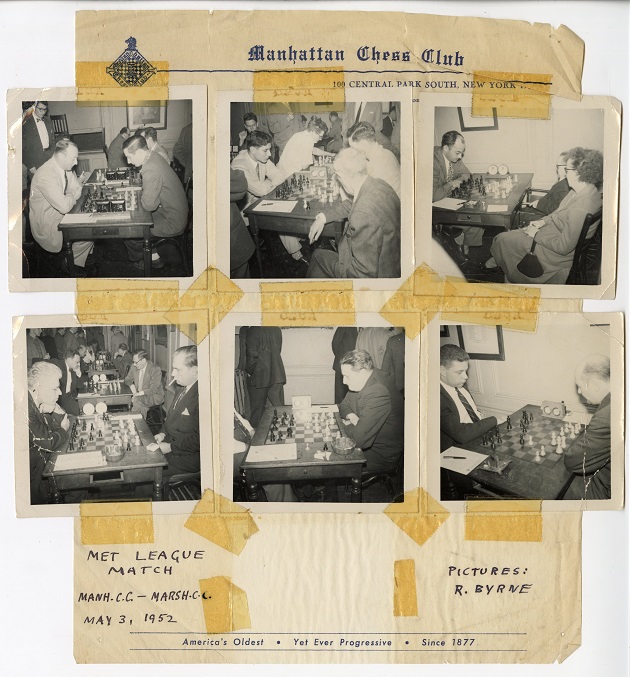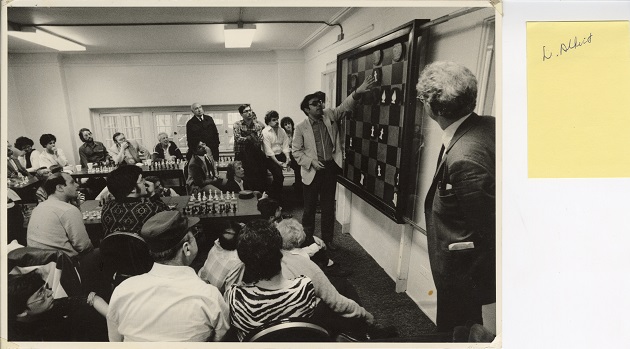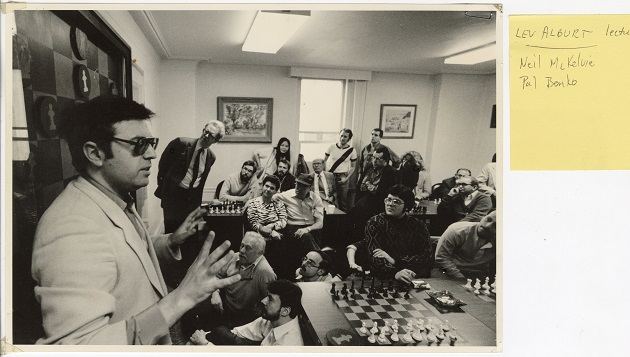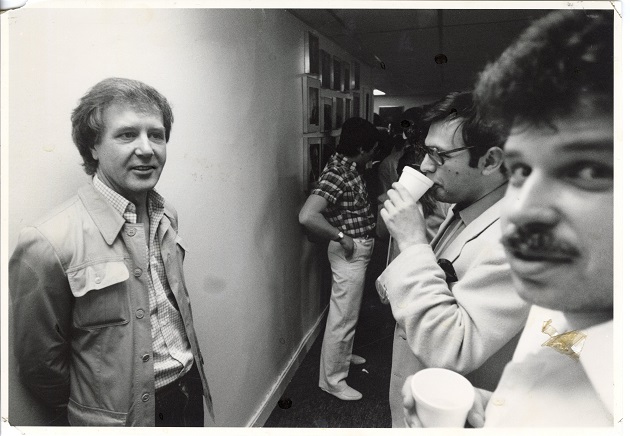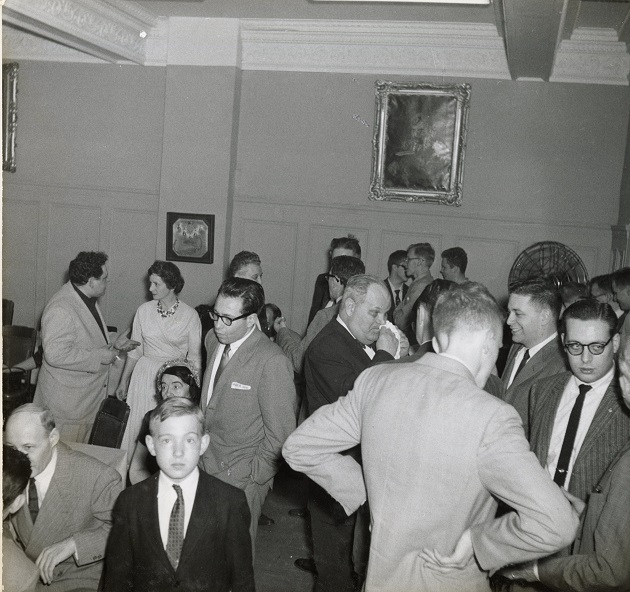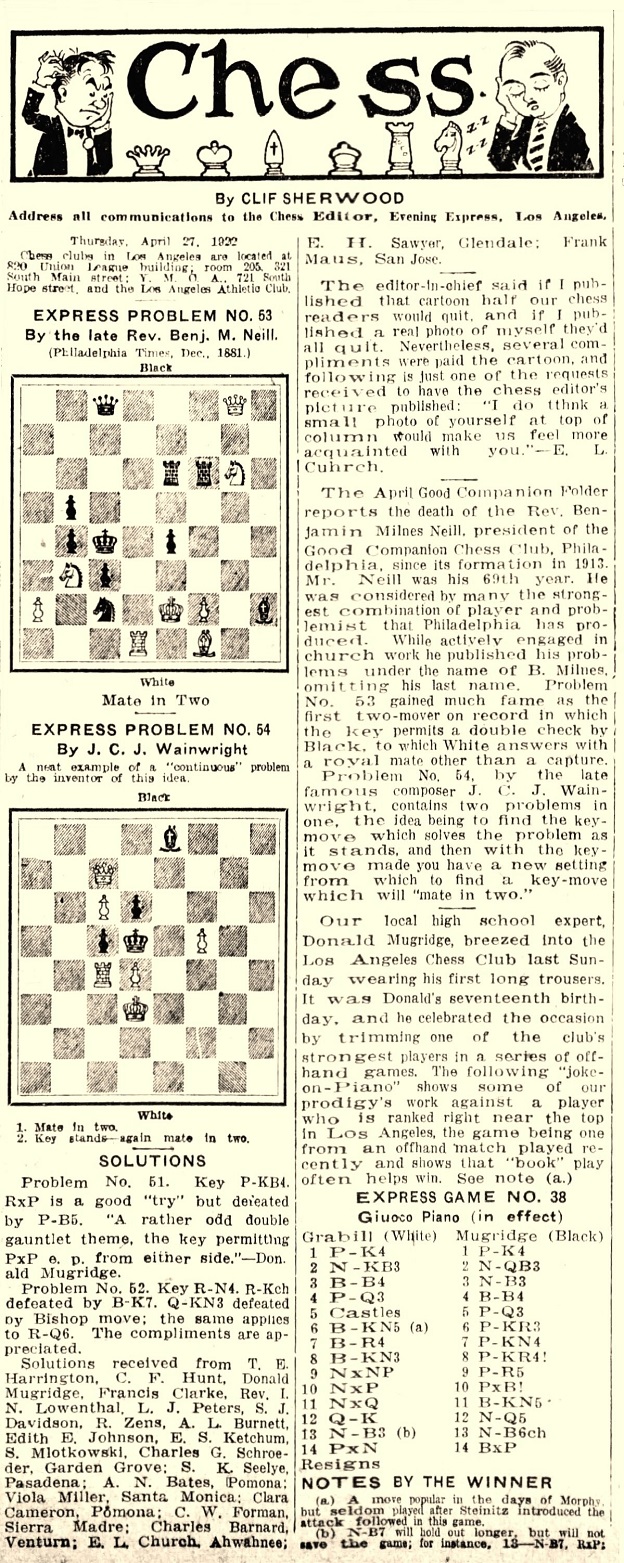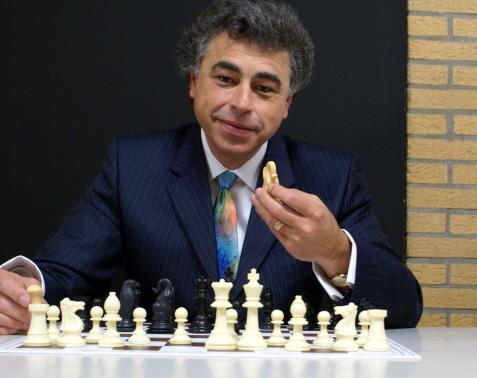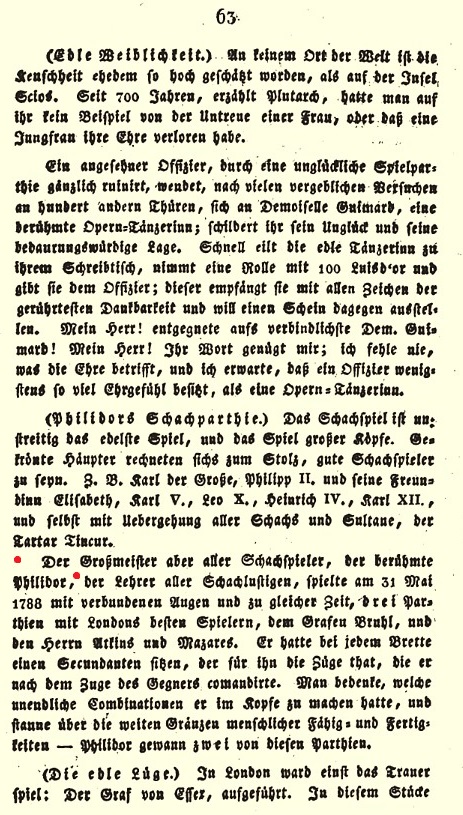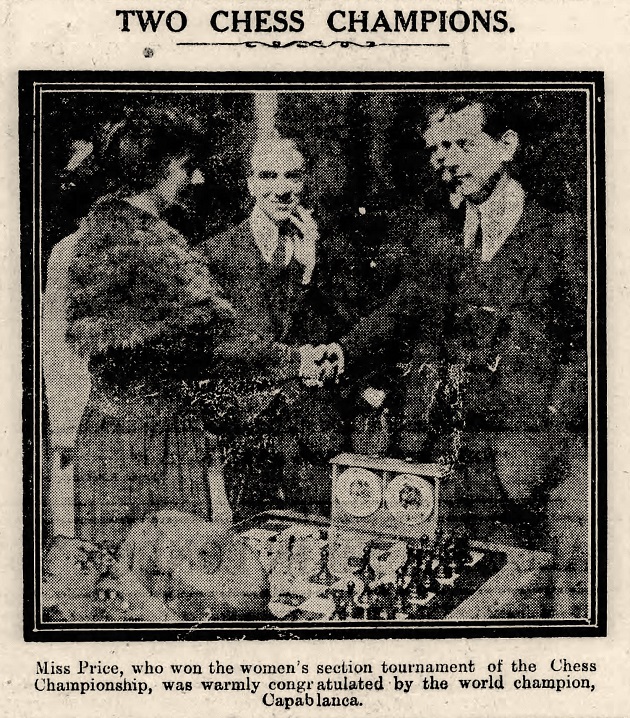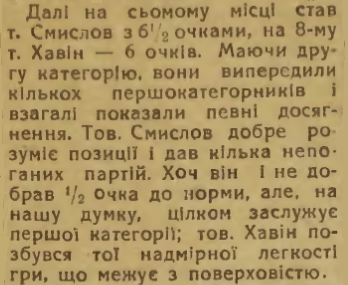11927.
Further Fischer material
John Donaldson (Berkeley, CA, USA) draws
attention to a website
which offers a large number of Fischer-related
newspaper articles.
He also writes:
‘I recently listened to a 2022 podcast
series on the Worldwide Church of God, where
one episode is on Bobby Fischer. One of the
people they talk with, a person who
interviewed Fischer in late 1976/77, when he
was disenchanted with the WWCOG, still has the
tape recordings of the interview. Although
they play only segments of the five hours,
some parts are interesting. Unless anyone in
the former Yugoslavia still has the press
interviews in which Fischer discussed a
possible 1978 match with Gligorić, it is
likely to be the last pre-1992 interview that
Fischer gave. It is Episode
1.7: ‘Finding Bobby Fischer: The Lost Tapes’.
Incidentally, late last year I had a
discussion with Eugenio Torre in St Louis. He
was reticent to speak about Fischer but did
confirm that he played only one training game
with him (a long draw in a 2 c3 Sicilian which
is known).’
The Torre v Fischer game was given in C.N. 8638.
11928.
Capablanca on Ståhlberg
Peter Holmgren (Stockholm) is seeking
substantiation of a claim, readily found on the
Internet without any source, that Capablanca
described Ståhlberg as ‘el león sueco’
(‘the Swedish lion’).
11929.
Castling
‘Castling is the first step towards a
well-ordered life’ is a familiar remark by Tartakower,
cited, for instance, in Wolfgang Heidenfeld’s
entry on (sourceless) chess aphorisms on page 16
of The Encyclopedia of Chess by Harry
Golombek (London, 1977).
The castling observation is one of dozens given
by Tartakower on pages 551-553 of the
Teplitz-Schönau, 1922 tournament book (shown below
courtesy of the Cleveland Public Library):
Thus page 553 has:
‘Rochade ist der erste Schritt zum
geordneten Leben.’
A number of other observations above will be
familiar. Concerning ‘Die Fehler sind dazu da,
um gemacht zu werden’ (customarily
translated as ‘The mistakes are all there, waiting
to be made’), we have now slightly amended the
Tartakower entry in The
Most Famous Chess Quotations, given that the
Teplitz-Schönau, 1922 tournament book predated our
source (Die Hypermoderne Schachpartie).
See too our feature article Castling
in Chess.
11930.
Lady Edith Margaret Thomas (C.N.s 5690, 9848
& 10680)
C.N. 5690 referred to a record of Sir George
Thomas’s chessplaying mother, Lady Edith Margaret
Thomas (née Foster), having been born circa
1853 at The Bogue, St Elizabeth, Jamaica.
Jon D’Souza-Eva (Oxford, England) reports that
now the FamilySearch
webpage states ‘Birth about 1846, Hanover,
German Empire’ and adds that she was christened in
Hanover on 25 January 1846.
Concerning Lady Thomas, see too the photograph in
Chess
and Women (C.N. 3281).
11931.
N.T. Whitaker
Further to our recent feature
article on Norman Tweed Whitaker, John
Hilbert (Amherst, NY, USA) has sent us a database
of over 40 games which he has traced since the
publication in 2000 of his book Shady Side:
The Life and Crimes of Norman Tweed Whitaker,
Chessmaster.
Two specimens:
Morton Eschner – Norman Tweed Whitaker
First match-game, Philadelphia, 1910
Ruy López
1 e4 e5 2 Nf3 Nc6 3 Bb5 a6 4 Ba4 Nf6 5 O-O Be7 6
c3 Nxe4 7 Re1 Nc5 8 Bxc6 dxc6 9 Nxe5 O-O 10 d4 Ne6
11 Nd2 c5 12 Ndf3 cxd4 13 Nxd4 Nxd4 14 cxd4 Be6 15
f4 Qd5 16 Be3 Rad8 17 Rc1 c6 18 a3 Bd6 19 Qc2 f6
20 Nf3 Rfe8 21 Qf2 Bb8 22 Rc5 Qd7 23 Rh5 Ba7 24
Qh4 g6 25 Rh6 Bd5
26 f5 Bxf3 27 fxg6 Bxd4 28 Rxh7 Bxe3+ 29 Rxe3
Qd1+ 30 Kf2 Rd2+ 31 Kg3 Rxg2+ 32 Kf4 Rg4+ 33 Qxg4
Qd4+ 34 White resigns.
Source: Philadelphia Item, 22 May 1910.
P. Driver – Norman Tweed Whitaker
Mercantile Library Chess Association
Championship, Philadelphia, 1911
Queen’s Pawn Opening
1 d4 d5 2 Nf3 c5 3 e3 e6 4 c4 Nc6 5 Nc3 Nf6 6 Bd2
dxc4 7 Bxc4 a6 8 O-O b5 9 Bb3 c4 10 Bc2 Bb7 11 e4
Be7 12 Bg5 O-O 13 e5 Nd5 14 Bxe7 Qxe7 15 Ne4 Ncb4
16 Nd6 Nxc2 17 Qxc2 Bc6 18 a3 f6 19 Rfe1 fxe5 20
dxe5 Nf4 21 Ne4 Qf7 22 Re3 Qg6 23 Ne1
23...Bxe4 24 White resigns.
Sources: Philadelphia Public Ledger, 23
April 1911 (courtesy of Neil Brennen) and the Staten
Islander, 17 May 1911.
11932.
Vladimir Nabokov
Brian Matthews (New York, NY, USA) brings to our
attention a webpage on Vladimir
Nabokov and chess.
11933.
Petra Leeuwerik and Victor Korchnoi
Olimpiu G. Urcan (Singapore) authorizes us to
show this photograph that he has acquired:
11934.
The Staunton chessmen
From John Townsend (Wokingham, England):
‘Although the pattern of Staunton chessmen
was registered officially in the name of
Nathaniel Cooke in 1849, it has been
questioned whether he was also the designer.
He is not otherwise associated with either
chess or artistic design, save to say that his
daughter, Harriet Ingram Cooke, seems to have
been the author of The ABC of Chess, By a
Lady, first published by John Jaques in 1860.
A short article in The Spectator, 17
November 1849, page 1087, entitled “The ‘Staunton’
Chess-men”, took the unusual step of naming the
designer. These were the concluding words:
“The carton-pierre chest, in which the men
are deposited, and which is decorated with
mediaeval arches and turrets, embossed with
the insignia of the game, does just credit to
Mr L.S. Williams, the artist; who has also, we
believe, designed the very solid and elegant
pieces.”
In fact, “Mr L.S. Williams” was incorrect,
and it is clear from a reply to a
correspondent, “Florence”, in the Illustrated
London News of the same date (page 11) that
the artist being referred to was “Mr Joseph L.
Williams”:
“The very beautiful and appropriate
box of Carton Pierre, in which the new
Chess-men are inclosed, is by Mr Joseph L.
Williams, the well-known decorative artist.”
Joseph Lionel Williams (1815-77), born in
Colchester, Essex, was a wood engraver,
draughtsman and watercolourist. He did much
illustrative work for the Illustrated
London News, as did his brother, Alfred
Williams.
Great caution is required before crediting
Joseph Lionel Williams with the design of the
Staunton chessmen, although, in view of the
article in The Spectator, it seems at
least possible that he designed the men as
well as the box.’
11935.
Disarray at the 1939 FIDE General Assembly
(C.N.s 11915, 11918 & 11925)
Our earlier items have referred to a current
discussion within FIDE concerning Alexander Rueb’s
tenure of the presidency, with links to FIDE
Chess Congress 1939: An Investigation by
Richard Forster and to his briefer account,
entitled Coup
or Call of Duty? Commotion at the 1939 FIDE
Chess Congress.
Pages 40-42 of the February 2023 CHESS
feature a further article by Dr Forster, ‘Buenos
Aires 1939: The putsch that did not happen’. The three-page article
is shown here with the permission of CHESS.
11936.
Luc Winants
The death has just been announced of Luc Winants,
aged 60.
A grandmaster with a deep knowledge of chess
history, he made many contributions to C.N., with
unfailing precision and good humour.
Below we reproduce two photographs (SWIFT
tournament, 1986), courtesy of Yasser Seirawan
(Hilversum, the Netherlands).
11937.
Alekhine
Bernd Schneider (Solingen, Germany) recently
auctioned a book which had, as its frontispiece, a
photograph of Alekhine that seemed new to us. Is
any information available about the picture
(absent from our copy of the Dutch edition)?
11938.
A complex study (C.N. 1831)
John Roycroft (London) wrote as follows in C.N.
1831 (about a position which he gave in the GBR
Code):
‘No. 156 in Tattersall’s A Thousand
Endgames (volume one) is attributed without
date or source to Troitzky. The position: a1a3
0005.11 a6f6d3.b3c3 4/3=. The solution: 1 Nb4
Nxb4 2 Ne4 c2 3 Nc3 Nd5 (3...c1(Q)+ 4 Nb1+) 4
Ne2 Kxb3 5 Nd4+. The Russians Evgeny Umnov and
Nikolai Kralin wish to trace the original
source (assuming that Troitzky was the genuine
composer) prior to publishing “the complete
Troitzky”. We may note that No. 670 in
Tattersall is also given as by Troitzky, but
it is in fact by F. Lazard if we are to
believe No. 979 in Sutherland and Lommer’s 1234
Modern End-Game Studies.’
White to move and
draw (?)
Now, we add that the van der Heijden database
shows that the study was by Carl Behting,
published in 1903 in Shakhmatnoe Obozrenie
and the Deutsche Schachzeitung, and that
it is cooked by 3...Kxb3.
Courtesy of Sergey Voronkov and Vladislav Novikov
(Moscow), below is the relevant part of page 130
of the Russian magazine (April 1903 issue):
The diagram on the left is the oldest composition
by Ossip Bernstein in the van der Heijden
database.
11939.
Simultaneous exhibitions by Staunton and Morphy
What was the largest number of games that either
Staunton or Morphy ever played simultaneously
(excluding the latter’s blindfold displays)?
This surprisingly difficult question has been
mentioned in, for instance, C.N.s 4492 and 11874
(see Howard
Staunton) and C.N. 10423 (see Paul
Morphy). Citations for numbers as low as
three or four will be welcomed, to start the ball
rolling.
11940.
Spanish website
Luis Méndez (Gijón, Spain) draws attention to his
website ‘Comentarios
de Ajedrez’.
Our correspondent is the co-author of a book
mentioned in C.N. 11383, The
Gijón
International Chess Tournaments, 1944–1965
(Jefferson, 2019).
11941.
Questions about Fischer’s My 60 Memorable
Games
Christopher Holmes (Saint-Maur-des-Fossés,
France) raises a number of points regarding
Fischer’s My
60
Memorable Games, originally published
in 1969 by Simon & Schuster in the United
States and by Faber and Faber in the United
Kingdom, followed by two Batsford editions (1995
and 2008). Quite apart from the unclear copyright
position concerning those English-language
editions, our correspondent wonders how a
potential translator or publisher of the book in
another language could set about clearing the
rights, through Fischer’s estate. Is the identity
of the appropriate contact person known?
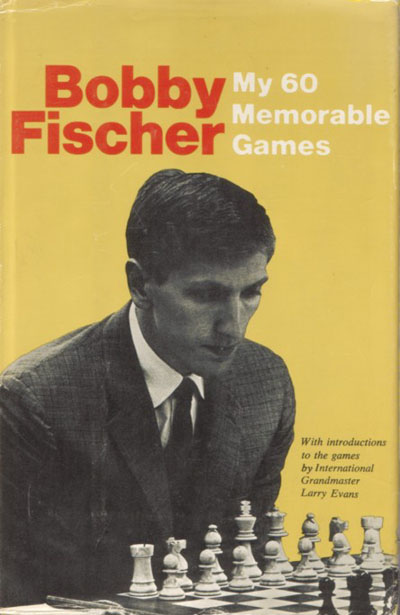 Our above-mentioned feature article described the
1972 French edition by Parviz M. Abolgassemi as
‘flavourless and inaccurate’, but it is hard to
imagine how a perfect new edition of Fischer’s
book could be produced in any language. Which
English-language version should be the basis for
any translation? How, if at all, should errata be
incorporated? Has anybody ever produced an
exhaustive list of corrections (on the basis of
what was published in 1969)? What attention, if
any, should be given to the multitude of alleged
analytical improvements in My
61
Memorable Games?
11942.
Mikhail Tal
Olimpiu G. Urcan (Singapore) provides this
portrait of Mikhail Tal, courtesy of the Daily
Telegraph archive:
11943.
Elaine Saunders
Mr Urcan also offers this addition, from the
Keystone archive, to our feature article The
Chess
Prodigy Elaine Saunders:
11944.
Blanco and Lasker
C.N.s 3471 and 3475 (see Chess
Cartoons
and Caricatures) have shown a caricature of
Emanuel Lasker by Rafael Blanco. Now, Yandy Rojas
Barrios (Cárdenas, Cuba) supplies a better-quality
version, from page 125 of El Fígaro, 4
March 1906:
11945.
Charles Thomas Stanley
From John Townsend (Wokingham, England):
‘In the 1840s, Charles Stanley, of the
Brighton Chess Club, had problems published in
the Illustrated London News, and
problems and a game in the Chess Player’s
Chronicle. (Details can be found in my book,
Historical notes on some chess players,
pages 93-94). Some writers have equated him
with Charles Henry Stanley, but that is
clearly wrong, since references which
associate the problemist Charles Stanley with
the Brighton Chess Club are after Charles
Henry Stanley had emigrated to the United
States in 1845.
Who, then, was the problemist? There is
strong evidence that he was a close friend of
Hugh Alexander Kennedy, a leading light at the
Brighton Chess Club. When Kennedy was married
on 14 November 1849 to Mary Georgiana Ward, at
St John’s, Hampstead, one of the two witnesses
who signed the marriage register was “C.T.
Stanley”. I have found only one “C.T. Stanley”
who this could reasonably be and that is “C.T.
Stanley, Esq., Lindfield” who for a number of
years appeared in the list of members printed
in Sussex Archaeological Collections,
for example, Sussex Archaeological
Collections, Vol. II, 1849, page xvi, where,
incidentally, “Captain Hugh Kennedy, Brighton”
appears on the same page.
Lindfield is a Sussex village which lies
about 15 miles to the north of Brighton, so it
would have given Stanley reasonable access to
the chess club. Peter Edmund Stanley, on page
374 of his book The House of Stanley
(1998), notes, as part of his chapter on “The
Stanleys of Preston”, that Charles Thomas
Stanley (1806-83) lived “for a number of
years” at Lindfield, and that is undoubtedly
who “C.T. Stanley” was.
Charles Thomas Stanley was the youngest son
of James Stanley, the vicar of Ormskirk,
Lancashire, and his baptism is recorded in the
Ormskirk register on 18 September 1812, noting
his date of birth, six years earlier, as 28
September 1806.
He was a cousin of the Earl of Derby and
used the same arms, crest and motto. His first
wife was Elizabeth Rosamond, the eldest
daughter of James Ward, of Surrey.
By 1881 he had moved to Charlton, near
Dover, Kent, where he is to be found on the
census (National Archives, RG11 1000/117).
This shows that he was then receiving income
from railway debentures and interest on
mortgages; he was with his second wife,
Catherine S. Stanley, who had been born at
Steyning, Sussex, and three children, Edmund
(18), Ernest (13) and Rosa (16), all born at
Brompton, Middlesex. This indicates that he
had lived at Brompton after Lindfield and
before Dover. He had no children by his first
wife.
He died at 7 Beaumont Terrace, Dover, on 23
September 1883. A death notice in the Evening
Mail of 1 October 1883 (page 8) stated that
he was a brother of the late Admiral Edward
Stanley. The National Probate Calendar records
that probate was granted to his relict,
Catherine Stepney Stanley, on 30 October 1883,
his personal estate amounting to £2,658 12s.
11d.’
11946.
The first Spanish chess champion
Luis Méndez Castedo and Pedro Méndez Castedo
(Gijón, Spain) draw our attention to a biography
of Manuel Golmayo de la Torriente which they have
just published. Sample pages are shown here with
the co-authors’ permission:
11947.
Lasker and Capablanca in their final years
Johannes Wiegand (Washington DC, USA) asks about
possible contact between Lasker and Capablanca in
the late 1930s and early 1940s, and the nature of
their relationship towards the end of their lives,
when both were living in New York.
Currently, we can quote only one account of their
having met. On page 120 of the third volume
(Berlin, 2022) of the Lasker
trilogy Richard Forster wrote:
‘Back in bustling New York, the Laskers had an
unusual guest in late summer [1940]: Capablanca
turned up. He was, Martha noted, so much more
likable than earlier, he was entertaining, and
all former jealousy and arrogance had gone. At
long last the two old champions were
reconciled.’
The source of this information is a Lasker diary
(see pages 114-115 of the book, which Richard
Forster co-edited with Michael Negele and Raj
Tischbierek).
Richard Forster has shown us the full entry by
Martha Lasker concerning her husband’s meeting
with Capablanca in 1940. About 260 words long, it
includes this remark about the Cuban:
‘Früher als er in Havana Em die
Weltmeisterwürde im Schach abgenommen hatte
(unter Einwirkung der Tropenhitze auf Em) war
er mir unausstehlich.’
11948.
Early 1920s photograph
This picture was given by us in a Chess
Mysteries
article at ChessBase.com on 20 November 2007
with this brief information:
The photograph above shows Alekhine at the
board with Rubinstein (watched by Tartakower,
Bogoljubow and Maróczy). It is taken from
Tartakower’s book Die Hypermoderne
Schachpartie, published in the mid-1920s,
and the credit reads ‘Friedmann, Wien’. Can a
better copy of the picture be found?
Now, Philip Jurgens (Ottawa, Canada) asks whether
anything further has come to light. Unfortunately
not, to our knowledge.
11949.
An Alekhine page
Florin Dănănău (Bucharest) supplies the
following, page 4 of Ilustrațiunea Română,
January 1936:
11950.
Tony Miles
Courtesy of the Daily Telegraph archive,
Olimpiu G. Urcan (Singapore) provides this shot of
Tony
Miles:
A stamp on the reverse gives the date 26 February
1976, and it is stated that the picture was taken
at Heathrow Airport, as Miles arrived from Dubna.
11951.
The Manhattan Chess Club
David Lyalin (Dunwoody, GA, USA) is writing a
novel, in Russian, which includes a scene at the
Manhattan Chess Club. He asks whether photographs
and descriptions of the interior of the Club are
available, his particular interest being in the
period 1941-56, when the Club was located at 100
Central Park South. He enquires about such matters
as how many rooms the Club occupied, their size,
and whether chess and card games were played in
different rooms.
We take the opportunity to invite similar
information about the Club throughout its
existence.
11952.
Players named Smyslov
This topic (concerning the father of Vassily
Smyslov and another player, from Kiev, also
named Smyslov) has been discussed in C.N.s 5606
and 10098. Now, further information has been
received from Dmitriy Komendenko (St Petersburg,
Russia):
‘Looking at the rusbase
website I have found that a player named
Smyslov played in the championship of Kiev at
least three times: 1929,
1930
and 1936.
Only his surname is given, with no forename or
patronymic, but I did find a reference to a
Victor Victorovich Smyslov on a Russian
website. Before it went offline I took this
screen-shot:
The text states that he was born in 1909 and
worked at the КИСИ (Киевский
инженерно-строительный институт), and his
interest in chess is mentioned.
In 1936 the Ukrainian chess newspaper Шахіст
had further information about the little-known
Smyslov from Kiev, including a photograph and
the fact that he was a second-category player:
Шахіст issue
3, 25 October 1936, page 1
Шахіст issue
6, 25 November 1936, page 2
The website
of the Kyiv National University of
Construction and Architecture has another
photograph of Smyslov, clearly the same person
as shown in Шахiст. It is also noted
that he studied in Kiev from 1927 to 1931,
moved to Moscow and returned to Kiev in 1936.’
11953.
Maurice Benyovszky
Dmitriy Komendenko also notes that the Russian
Wikipedia
page for Maurice Benyovszky (1746-86) refers
to his interest in chess and connection with
Benjamin Franklin:
‘Во время пребывания в Париже Бенёвский
увлёкся шахматами и на этой почве сблизился с
американским посланником Бенджамином
Франклином, который впоследствии принимал
деятельное участие в воспитании его детей.’
Is further chess information available?
11954.
Horatio Bolton
Mate in seven
Concerning this problem by Horatio
Bolton, given in C.N. 134, Guy Meissonnier
(Maisons-Alfort, France) draws attention to the
article ‘Un célèbre problème d’Horatio Bolton’
by François Fargette on page 2238 of Thèmes-64
issue
113 (January-March 1984).
11955.
Folke Rogard and Fedor Bohatirchuk
From Henrik Malm Lindberg (Uppsala, Sweden):
‘I am writing a book on the second FIDE
President, Folke
Rogard, in his capacity as organizer of
modern chess during the Cold War period. His
presidency ran from 1949 to 1970 and was
replete with events which can and should be
seen in the light of the battle between East
and West.
A particular question concerns the
Ukrainian/Soviet master, Fedor Bohatirchuk,
who was later a Canadian champion. He settled
in Canada in 1949 and then fought to receive a
GM, or at least an IM, title from FIDE for his
accomplishments during, in particular, the
1930s. The matter was settled at the 1954 FIDE
Congress, when he received the IM title. Twice
it had been discussed by the FIDE
Qualifications Commission, but the Soviets
(Ragozin) had objected. Prior to 1954, Rogard
was criticized by Canadians (especially
Bernard Freedman), and it appears that
agreement was reached in 1954 after a Soviet
visit (Kotov and Bondarevsky) to Canada.
From the FIDE archives in Leeuwarden I have
a letter dated 6 August 1954 from Freedman to
Rogard which reported on an agreement for
Bohatirchuk to be an IM “by Right and by
Strength”. Are any other sources known which
either confirm or contradict this account?’
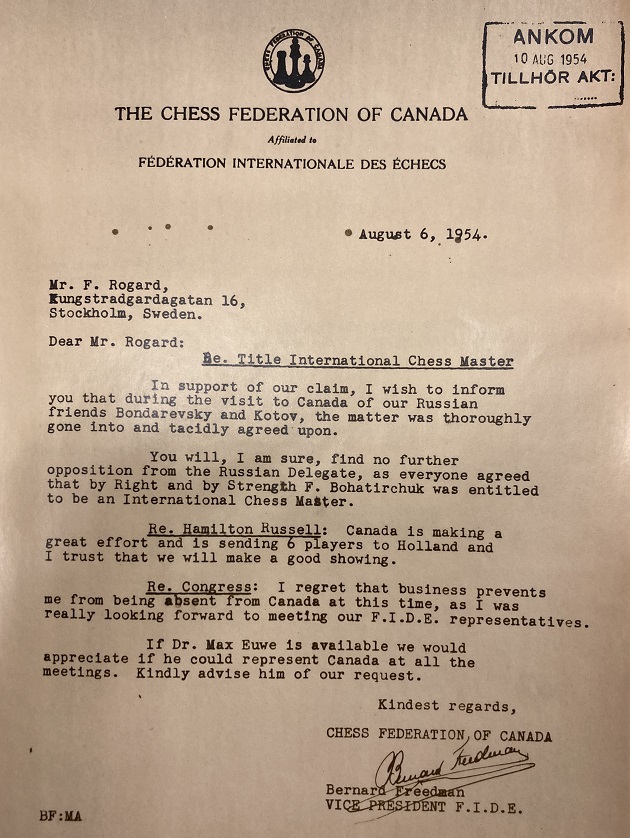
11956.
Projected Botvinnik book
In C.N. 979 we wrote:
The September 1977 Chess Life & Review
(pages 491-492) has an article by Frank Brady on
the Capablanca-Botvinnik simul game of 1925 (‘an
extract from Frank Brady’s Soviet Master,
a biography of Dr Mikhail Botvinnik, to be
published in 1978’ – what has happened?).
Frank Brady (New York, NY, USA) informs us:
‘I had been in correspondence with Yakov
Estrin in the early 1970s about penning a
biography of Botvinnik and had received a
positive response of interest. While in
Iceland during the 1972 match I wrote to
Botvinnik requesting a meeting in Macedonia
during the Olympiad. He granted the request,
and we met with Albéric O’Kelly de Galway as
an interpreter. It was a fascinating meeting,
but we could not come to terms about my
becoming Botvinnik’s biographer.
Several years later, Burt Hochberg, who was
the chess consultant for David McKay Co.,
asked if I would be interested in writing
about Botvinnik, and although it looked like
it would happen I never received a contract,
for reasons unknown. I assume that is the book
“Soviet Master” referred to.’
11957.
Simultaneous displays by Emanuel Lasker
Olimpiu G. Urcan points out two
photographs
of Emanuel Lasker giving a simultaneous display.
For a list of Lasker’s exhibitions, see the Emanuel
Lasker Online website.
11958.
Rafael Blanco (C.N.s 11812 & 11944)
Yandy Rojas Barrios (Cárdenas, Cuba) provides a
much better copy of the two-page article about
Blanco (C.N. 11812), pointing out that the exact
date of publication in El Fígaro was 23
July 1911:
Larger version
Larger version
11959.
Abrahams v Thynne
White to move
The Abrahams v Thynne brilliancy was discussed in
C.N.s 3158 and 3167 (see pages 278-279 of Chess
Facts and Fables), but we have not yet
quoted C.J.S. Purdy on the game. He annotated it
on pages 315-316 of the Australasian Chess
Review, 12 November 1936 with this
introduction:
‘We all enjoy bombshell moves. The 20th move in
this game makes a loud enough explosion for
anybody. Abrahams specializes in bombing.’
Purdy gave 20 Qg8+ three exclamation marks.
11960.
Fedor Bohatirchuk (C.N. 11955)
From Stephen Wright (Vancouver, Canada):
‘Below are a few sources on Bernard Freedman
and the IM title for Bohatirchuk. It should be
noted that Freedman organized (at short
notice) the tour for the visiting Bondarevsky
and Kotov in June/July 1954; he was also the
Secretary of the Canadian Correspondence Chess
Association and he used its Bulletin
as a vehicle to disseminate news, including
FIDE-related subjects. Business pressures
meant that he could not attend the 1954 FIDE
meetings in Amsterdam.
From a report on the Bondarevsky and Kotov
tour:
“It had been planned they play two
match-games with two new Canadians now in our
capital city: Dr F. Bohatirchuk, who fled his
Russian homeland in 1943, and Yugoslav-born
George Berner, who came to this country
two-and-a-half years ago. Bohatirchuk can
boast a plus score against the world champion,
while Berner’s credentials indicate a
mastership in his own land. In a last-minute
back-track, however, the touring Russians
side-stepped these face-to-face matches.
Instead, they elected simultaneous exhibitions
against all-comers.” (Source: Daniel
MacAdam (?), Canadian Chess Chat,
June-July 1954, page 14.)
Freedman’s comments on the same incident:
“Kotov did not want to play G. Berner an
individual match, stating that being an
International Grand Master he had come to
Canada desirous of meeting Canadian Champions
or Chess Masters and that there would be no
merit in playing a non-Canadian with no
International Master Title. He was, however,
prepared to play him in a match with clocks
simultaneously with other Ottawa top-ranking
players. As to Dr Bohatirchuk, whom they
acknowledged was of International Master
calibre, he was not asked to play and had
himself no desire whatsoever of playing.” (Source:
Bernard Freedman, Canadian
Correspondence Chess Association Bulletin
#215, July 1954, page 2.)
Concerning Dr F. Bohatirchuk and the title
of International Master:
“Correspondence was exchanged with the
President of the FIDE concerning the refusal
to our request last year. I was pretty harsh,
and violently protested on behalf of Canada.
The request has once more been made and as a
result of letters, also talks with the Russian
Delegates and others we trust that we may have
our request granted ‘by right’ at the next
General Meeting of FIDE being held in
Amsterdam, August 1954.” (Source: Bernard
Freedman, Canadian Correspondence
Chess Association Bulletin #216, August
1954, page 3.)
Despite these positive views, the request
was initially declined again. From Divinsky’s
report on the FIDE meetings:
“I am extremely happy to be able to report
that Dr F. Bohatirchuk is now an International
Master. The Qualification Committee had met on
Sunday morning, 29 August, and I arrived in
the afternoon to discover that Dr Bohatirchuk
had been turned down because his strength was
considered insufficient. There was no
disagreement over his right to be considered
on his past record. I re-opened his case under
the heading ‘New Business’ and claimed that
his record was better than that of either
Goglidze or Verlinsky. Flohr denied this.
Najdorf, who had previously spoken against Dr
Bohatirchuk, admitted than he knew nothing
about Moscow, 1925, or about Dr Bohatirchuk’s
record prior to 1949. I proposed that Dr
Bohatirchuk be admitted now on condition that
his record proves to be stronger than that of
either Goglidze or Verlinsky. A special
meeting of the Qualification Committee was
called, in which Dr Bohatirchuk was admitted,
unanimously, with Russia abstaining from
voting.” (Source: Nathan Divinsky, Canadian
Chess Chat, August-September 1954, page
22.)
The subsequent press release:
“TORONTO (CP) – Canada’s three-year fight to
have Dr Fedor Bohatirchuk named its third
international chess master has ended
successfully. Russia withdrew its opposition
to recognition of the X-ray research expert
who fled from Russia to Canada by way of
Germany. Bernard Freedman, President of the
Chess Federation of Canada, said today that he
had received word from Fédération
Internationale des Echecs, the world chess
body to which he is the Canadian
representative, that the University of Ottawa
anatomy professor’s claim had been recognized
‘on merit’.” (Source: Times-Colonist,
9 September 1954, page 21.)
There was an exchange in Canadian Chess
Chat which provides background on, and
illustrates, some of the feelings at the time.
Wade wrote a long report on the 1952 FIDE
Congress which was serialized in the October,
November and December 1952 issues of the
magazine; Ferguson’s remarks were explicitly
stated to be his personal opinion “and have no
connection with any office I may hold in
organized chess”. He was elected President of
the CFC in 1953 but did not serve out his
term, being replaced by Nathan Divinsky. Wade
was also a target because he proposed that
Canada lose its zonal status.
“There were distinct hints of trouble over
Canada’s nomination of Bohatirchuk for the
title of international master. There is no
issue on the question of his strength, but his
actual international results are not
impressive due to his not being a prize-winner
in events that were colossally strong like
Moscow, 1925, when the top players were
Bogoljubow, Lasker and Capablanca. However,
there is an underlying political issue as the
USSR regard Bohatirchuk as a renegade. It must
be realized that a vote on the issue as to
whether Bohatirchuk is to be granted the title
will resolve itself as follows: – against –
all the Stalinist Communist countries plus
those of the countries who are (a) unwilling
to offend personal friends who are delegates
from the above Communist countries, and (b)
genuinely uncertain about the merits of the
case, either politically or on strength as a
chessplayer. It is quite impossible to have an
objective discussion on this question. Your
Federation must decide whether to split the
FIDE, without probable gain of principle. I
personally judge him worthy of the title on
the grounds of strength and do not wish to
consider any political question. I would be in
a minority. Is it worth fighting? There was no
decision this year.” (Source: Robert G.
Wade, Canadian Chess Chat, October
1952, page 22.)
“The so-called ‘report’ of the meandering Mr
Wade, which appeared in the October issue of Chess
Chat, afforded this reader once again a
renewed amusement at the continued antics of
this chess mountebank, and at the self-assumed
importance of his activities and opinions, his
condescending and gratuitous lectures to the
Chess Federation of Canada, and thereby to
Canadian chessplayers in general, on matters
which are important to our continued support
of FIDE and our interest in international
chess.
The latest instance of this, his chiding of
the CFC for nominating Doctor Bohatirchuk for
the title of International Master, is another
example of that supercilious impertinence he
consistently displays toward the CFC – and
also of the never failing sycophancy of his
attitude par con-contra [sic] towards
his friends, those ‘delegates’ who represent
the Communist countries – (the words are his
own) whom he ‘does not wish to offend’. In the
manner of the dear old lady who reproaches the
small boy who spoke out of turn, he tells us
that ‘there were distinct hints of trouble’ at
the FIDE meeting as a result of our temerity
in making this nomination, he also tells us
that the evasion of a decision this year on
this matter by the FIDE, was due apparently to
a fear of ‘splitting’ the FIDE by displeasing
the gas-house gang boys, the USSR delegates
and their more or less amiable stooges. He
tells us that to vote for the nomination would
have left him in a ‘minority’ – as though
there were never any virtues in minorities. Of
course it is obvious that there would never be
any danger of Wade being in a non-Communist
minority in any case, especially in such an
instance as this, where the Big Boys decided
to make a propaganda issue ‘à la Russe’ out of
a simple matter.
Wade somewhat clumsily admits that it would
be impossible to get ‘an objective discussion’
on the Bohatirchuk matter, because although
there is ‘no issue on the question of his
strength’, there IS an underlying political
issue, viz., that the Russians regard
Bohatirchuk as a ‘renegade’. Well, it may have
been underlying, but Wade very maladroitly
brought the dirty mess to the surface in as
unconscious a manner as a circus buffoon.
Wade’s remark that Bohatirchuk’s ‘actual
international results are not impressive due
to his not-being a prize-winner in events that
were colossally strong, like Moscow, 1925’ is
as piffling and fatuous a statement as even he
could make. Was this the criterion applied to
those who were granted the title sought for
Bohatirchuk? We know better. Mr Wade turns to
us and asks us, ‘Is it worth fighting?’ He
talks of OUR ‘having to decide whether to
split the FIDE without probable gain of
principle’. Well, back in the days when I was
the age of Wade, we were taught that
principles were above expediency, and
especially so in the case of a ruthless and
vindictive bully. It is to be noted that
nowhere does the ineffable Wade tell his
‘friends’ from Moscow et al, that
their actions are in danger of ‘splitting the
FIDE’. It is the old story of every
international congress in which the Russians
have taken part in the past 20 years at least,
in any field of international operations
whatever, there must be two sets of ethics,
two sets of rules, and one almighty veto
either in fact or in effect.” (Source:
Graham G. Ferguson, Canadian Chess Chat,
December 1952, page 11.)’
11961.
US chess clubs
Information is still being sought about the
infrastructure and amenities of the Manhattan
Chess Club (C.N. 11951). In the meantime, Stephen
Davies (Carlton North, Australia) has provided an
article entitled ‘The Homes of Chess’ in the New
York Sun, 8 November 1891, page
22:
Larger
version
11962.
Marshall’s golden move
As shown in Marshall’s
‘Gold
Coins’ Game against Levitzky (or Levitsky)
at Breslau, 1912, 23...Qg3 was played:
Now, Michael McDowell (Westcliff-on-Sea, England)
points out that Marshall used a similar theme in a
problem which was listed as a non-prizewinner on
an unnumbered page of volume one, issue seven of The
Good Companion Chess Problem Club (March
1914 tourney):
Mate in two
11963.
US chess clubs (C.N.s 11951 & 11961)
The Cleveland Public Library has provided us with
the images shown below. Some individuals are
easily recognizable, but we invite readers to help
identify any who are relatively obscure:
ONE:
Larger
version
TWO:
Larger
version
THREE:
Larger
version
FOUR:
Larger
version
FIVE:
Larger
version
11964.
Grabill v Mugridge
Noting the discrepancies in Confusion
over the occasion of the well-known Grabill v
Mugridge brilliancy (1 e4 e5 2 Nf3 Nc6 3 Bc4 Nf6 4
d3 Bc5 5 O-O d6 6 Bg5 h6 7 Bh4 g5 8 Bg3 h5 9 Nxg5
h4 10 Nxf7 hxg3 11 Nxd8 Bg4 12 Qe1 Nd4 13 Nc3 Nf3+
14 gxf3 Bxf3 15 White resigns), Eduardo Bauzá
Mercére (New York, NY, USA) has sent us the game’s
appearance, with brief notes by the winner, on
page 19 of the Los Angeles Evening Express,
27 April 1922, in the chess column of Clif
Sherwood:
11965.
Capablanca chess
With regard to C.N. 5622 in the section on
‘Capablanca chess’ in Chess
Variants and Rule Changes, Yasser Seirawan
(St Louis, MO, USA) writes:
‘Both Bruce Harper and I take pride in
“adapting” Capablanca’s pieces to the 8 x 8
board with the creation of “S-Chess”, as
opposed to Capa’s suggestion for a 10 x 10
board. Is it possible that others before us
also tried to “improve” on Capa’s variant? Did
any of the proposals try to make Capa’s new
pieces “fit” on an 8 x 8 board?’
Our feature article Yasser
Seirawan points out a webpage
with further details of his variant, and we gave
this photograph:
11966.
Herman Melville
Paul Kollar (Oxford, CT, USA) has recently been
re-reading Herman Melville’s posthumous work Billy
Budd, Sailor, and has come across the
following passage (page numbers vary according to
the edition):
‘The sailor is frankness, the landsman is
finesse. Life is not a game with the sailor,
demanding the long head; no intricate game of
chess where few moves are made in
straightforwardness, and ends are attained by
indirection; an oblique, tedious, barren game
hardly worth that poor candle burnt out in
playing it.’
11967.
‘Grandmaster’
On the subject of early usage of the term ‘grandmaster’,
or equivalents in other languages, Nick Pope (Ann
Arbor, MI, USA) sends the following in relation to
Philidor from page 63 of volume three of Lesefrüchte,
belehrenden und unterhaltenden Inhalts
(Munich, 1828):
11968.
Good-quality pictures sought
Photographs
of
Capablanca shows many interesting pictures
from Soviet publications for which no good copy
has yet been traced. The same frustration arises
in numerous other cases, such as the shot below
which Olimpiu G. Urcan (Singapore) found on page 3
of the Liverpool Evening Express, 21
August 1922, i.e. shortly after the conclusion of
the London
Congress:
11969.
Hoffer v N.N.
C.N. 290 reproduced the following game from the
‘Brilliancies’ chapter on page 288 of the Year-Book
of Chess 1914 edited by M.W. Stevens
(London, 1915), where ‘Hoffer is White’ was the
only information given:
1 e4 e5 2 Nf3 Nc6 3 Bc4 Nf6 4 Ng5 d5 5 exd5 Na5 6
Bb5+ c6 7 dxc6 bxc6 8 Qf3 Qb6 9 Nc3 Be7 10 d3 h6
11 Be3 Qc7
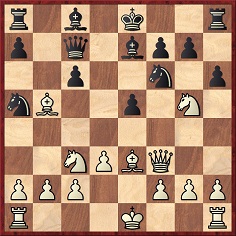
12 Nd5 Nxd5 13 Qxf7+ Kd8 14 Qxd5+ cxd5 15 Nf7
mate.
The Golden
Treasury
of Chess (various editions) gave the
game as ‘played about 1880’, but details are still
lacking.
11970.
Olson v Altmann
A second game shown in C.N. 290, also courtesy of
page 288 of the Year-Book of Chess 1914,
was headed ‘Olson v Altmann, Altmünchen C.C.,
1913’:
1 e4 e5 2 Nf3 Nc6 3 Bb5 a6 4 Ba4 Nf6 5 O-O Nxe4 6
d4 b5 7 Bb3 d5 8 dxe5 Be6 9 c3 Be7 10 Re1 Na5 11
Bc2 O-O 12 Nbd2 Nxd2 13 Bxd2 c5
14 Bh6 gxh6 15 Qd3 f5 16 exf6 Rxf6 17 Qxh7+ Kf8
18 Rxe6 Rxe6 19 Ne5 Rxe5 20 Bg6 and mates next
move.
Richard Forster (Winterthur, Switzerland) has
found that the game was published on page
11 of the Münchener Neueste Nachrichten,
4 January 1914.
11971.
‘Chess is not for the faint-hearted’
A remark often found attributed, sourcelessly, to
Steinitz is:
‘Chess is not for the faint-hearted; it absorbs
a person entirely. To get to the bottom of this
game, he has to give himself up into slavery.
Chess is difficult, it demands work, serious
reflection and zealous research.’
Richard Forster points out the following text on
page iv of Ludwig Bachmann’s final volume on
Steinitz:
‘Zum Schlusse führe ich noch aus dem
interessanten Gedankenaustausch, den der
Verfasser 1896 mit Steinitz hatte, einige
bemerkenswerte Ausführungen zu seiner
Charakteristik an: “Das Schach ist nichts für
kleine Geister, es beansprucht einen vollen
Mann, der sich nicht sklavisch an das
Überlieferte hält, sondern selbständig die
Tiefen des Spiels zu ergründen sucht. Es ist
wahr, ich bin ein schwieriger, kritischer
Kopf; aber sollte man da nicht kritisch
werden, wenn man so oft oberflächliche Urteile
über Stellungen anhören muss, deren wahrer
Wert erst durch tiefgründige Forschung
klargestellt werden kann. Soll man sich nicht
ärgern, wenn man sieht, wie unselbständig an
veralteten Methoden festgehalten wird, bloß
damit man nicht in seiner Bequemlichkeit
gestört wird. Ja das Schach ist schwer, es
erfordert Arbeit, ernstes Nachdenken, nur
eifrige Forschung kann befriedigen. Nur
rückhaltlose Kritik kann zum Ziele führen.
Aber der Kritiker gilt leider vielen als Feind
statt als Führer zur Wahrheit. Mich aber wird
Niemand vom Wege zur Wahrheit abbringen.”’
Our correspondent also draws attention to page 39
of Reuben Fine’s The Psychology of the Chess
Player (New York, 1967), where this
translation of Steinitz’s 1896 letter to Bachmann
is given:
‘Chess is not for timid souls. It demands a
whole man, who does not stick slavishly to what
has been handed down, but attempts independently
to probe the depths of the game. It is true that
I am not easily pleased and critical, but
shouldn’t one become critical if one so often
has to hear superficial opinions about positions
which can only be clarified by a thorough
investigation. Shouldn’t one worry if one sees
how antiquated methods are clung to in a
dependent way merely to avoid having one’s
comfort disturbed. Yes, chess is difficult, it
demands work, serious reflection, only diligent
investigation can satisfy. Only ruthless
criticism can lead to the goal. But for many
unfortunately the critic is seen as an enemy
rather than as a guide to the truth. But no-one
will ever draw me away from the road to the
truth.’
11972.
Morphy’s puzzling words
C.N.s 2026 and 2030 (see page 321 of Kings,
Commoners and Knaves and Paul
Morphy) reported the statement by his niece
that Morphy would walk up and down his verandah
muttering, ‘Il plantera la bannière de Castille
sur les murs de Madrid au cri de Ville gagnée,
et le petit Roi s’en ira tout penaud.’
John Townsend (Wokingham, England) writes:
‘Has anyone tried to relate these words to
events in Spanish history? Presumably, there
are only a limited number of occasions when
Madrid could be referred to as ville
gagnée, captured by Castilians. One instance
is its conquest by Alfonso VI of León and
Castile in 1085. The Moorish king at that
time, Boabdil, was nicknamed el rey chico,
which calls to mind the words attributed to
Morphy (“le petit roi”). If Morphy was
alluding to this event, then why? He had
Castilian ancestry on his father’s side.’
|
